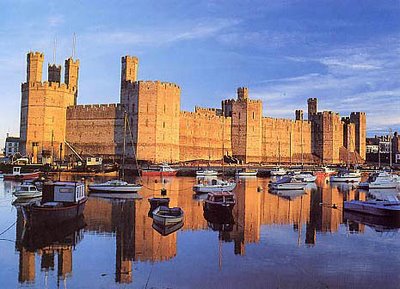Caernarfon Castle Paintings

History: In the uprising of 1294 -1295, Caernarfon was besieged, but the garrison was supplied by sea and held out to be relieved in the spring of 1295. In 1403 and 1404 it withstood sieges by the forces of Owain Glyndwr. During the English Civil War its Royalist garrison surrendered to Parliamentary forces in 1646.
Caernarfon Castle is one of the most impressive of all the castles built by Edward I and is one of Europe's great medieval fortresses. Set on a peninsula bounded by the Menai Strait and at the heart of North Wales, Caernarfon became the English administrative centre.

Robinson and Thomas (qv) say that "... King Edward seems to have gone to considerable lengths to give substance to the tradition linking Caernarfon with imperial Rome. The king must have known that the Roman fort of Segontium, lying just above the modern town, was inseperably associated in legend with Magnus Maximus, the usurper emperor. Maximus appears as the Macsen Wledig of the Mabinogion, and it is Segontium which provides the background to his dream of journeying from Rome into a land of high mountains facing an island. There he saw a great city with towers of many colours and eagles fashioned out of gold.
Thus it was that at Caernarfon, the walls were given a prominent patterning with bands of different coloured stone. Moreover, the towers were constructed in an angular fashion rather than the usual rounded form of, for example, Conwy or Beaumaris. It is difficult to escape the conclusion that Edward was drawing upon symbolism, and turned for inspiration to the great city of Constantinople. There, in the eastern successor to Rome and one of the wonders of the ancient world, the fifth century walls bear a striking resemblance to this late thirteenth century castle." Today, the castle houses the Museum of the Royal Welsh Fusiliers, Wales' oldest regiment, and there are a number of exhibitions housed within its towers. You can also take a walk around the well preserved town walls.
Aside from the castle there is also a Roman fort, the Welsh Highland Railway, a floating restaurant, the Performing Arts Centre, craft shops, restaurants, the area's largest "Fun Centre", a golf course and indoor swimming pool and sports facilities at the Leisure centre. Whatever your interests, you'll be able to find something to do, even if the British weather lets you down.








0 Comments:
Post a Comment
<< Home